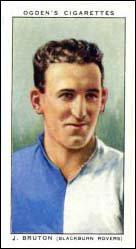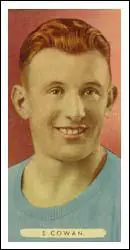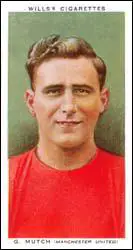Football and the Tobacco Industry
The tobacco companies discovered that cigarette cards were a great way to obtain brand loyalty. In 1896 the first football set appeared. Footballers & Club Colours was published by Marcus & Company, a small firm in Manchester. Over the next forty years millions of these cards were produced in an attempt to identify football stars with smoking.
Some football stars such as Billy Meredith and Bill Shankly made it clear that they maintained their fitness by neither smoking or drinking alcohol. However, others such as David Jack, openly stated that he was a chain-smoker. It was also common for newspapers and magazines to publish photographs of football players smoking.



In the late 1800s the newspapers were concerned about the example being set by the football players. In his book, Iron in the Blood, John Powles, points out that a journalist reported after one London League game: "I am not an anti-tobacconist but I do not think it is at all good form for a goalkeeper to be seen smoking a cigarette in goal whilst the game is in progress, and for a linesman to be seen smoking a pipe. Yet both incidents occurred on Saturday at Ilford."
After the First World War the former star footballer, Charlie Roberts, established a wholesale tobacconist business in Manchester. Roberts created a cigarette which he called "Ducrobel" after the Manchester United half-back line of Dick Duckworth, Charlie Roberts and Alec Bell.
In the 1930s Dixie Dean promoted Carreras Clubs, "the cigarettes with a kick in them". According to Joyce Woolridge: "Dean, pictured in the publicity with a lighted cigarette clamped firmly between his lips, was obviously chosen for his appeal to working-class men; Clubs were a budget brand at five for two pence."
Herbert Chapman, the manager of Arsenal, did what he could to stop his players from smoking or drinking alcohol. In October 1927, Chapman signed Eddie Hapgood, a 19 year old milkman, who was playing for non-league Kettering Town for a fee of £750. In his autobiography Hapgood describes his first meeting with Chapman: "Well, young man, do you smoke or drink?" Rather startled, I said, "No, sir." "Good," he answered. "Would you like to sign for Arsenal". Hapgood later wrote in his autobiography, Football Ambassador, "That remark of Mr. Chapman's about smoking and drinking impressed itself on my mind, for I have never done either during my career, with the exception of drinking occasional toasts at banquets and other functions."
Frank Buckley, the manager of Wolverhampton Wanderers, was also opposed to smoking. Buckley gave each of his players a small pocket book in which was printed details of the conduct he expected from them. As well as advice on not smoking, he insisted that they did not go out socialising for a least two days prior to a match. Buckley also informed the Wolverhampton public of these regulations and asked them to contact him if they saw a player breaking the rules.
It was common for footballers to smoke in the early 1950s. Jackie Milburn pointed out in his autobiography that he rushed off to the Wembley toilets for a cigarette before the 1951 FA Cup Final and found that four of his Newcastle United teammates were already there having a smoke. He added: "No fewer than nine of our team smoked and on three occasions at Wembley in a Cup final I've sat at half-time having a fag." In fact, the club used to provide the players with free cigarettes. Milburn, like many footballers of this period, died of lung cancer.
Although he did not smoke himself, fitness fanatic, Stanley Matthews appeared in an advertisement for Craven A cigarettes in 1954. The advertisers attempted to link his "smooth ball control" with the "smoothness of Craven A". This was at a time when research was being published showing a link between smoking and cancer and Matthews was criticized for appearing in cigarette advertising.
Primary Sources
(1) Archie Hunter, Triumphs of the Football Field (1890)
Alexander Latta, of the Everton team, whom I well remember taking a notable part in the International contests, Scotland versus Wales and Scotland versus England. He is a Dumbarton man and the next remarkable thing to his play is that he doesn't drink or smoke.
Now don't think that I mean to suggest that the majority of football players are intemperate, or that they are given to over-indulgence either with ale or tobacco. There is an impression abroad - especially among those who don't know anything about the game and the players - that after every match the members go to the nearest tavern and drink as hard as they can. Well, you may find them in a tavern, because it is usual to reassemble in some convenient place; but I deny that footballers on such occasions go beyond proper limits. On the contrary, they are very moderate indeed in this way. The fact is they are obliged to be, or they would be no good. When in strict training they can't be too careful; and though a man who is accustomed to having a glass of ale at his dinner is not forbidden to take it, yet if he can do without it he is told to abstain. Any recklessness in drinking and smoking would soon tell upon a player, and you wouldn't see him playing very long. Though it is unusual to find a man both a teetotaler and a nonsmoker, yet it is not uncommon to find a man either the one or the other; and I should like my experience in this respect to be known.
(2) Eddie Hapgood, Football Ambassador (1945)
After a dozen games, Bill Collier, the Kettering manager, called me into his office and introduced me to a chubby man in tweeds, whose spectacles failed to hide the shrewd, appraising look from his blue eyes. I didn't know it then, but I was to see this man many times before he died so tragically seven years later.
"Eddie, this is Mr. Herbert Chapman, the Arsenal manager," said Bill Collier. "And the other gentleman is Mr. George Allison." And so I met two of the men who were to play such a major part in my future football career.
Herbert Chapman didn't say anything for a few seconds, then shot out, " Well, young man, do you smoke or drink?" Rather startled, I said, "No, sir." "Good," he answered. "Would you like to sign for Arsenal" Would I. I could hardly set pen to paper fast enough. I believe Mr. Chapman paid Kettering roughly £1,000 for my transfer - £750 down and a guarantee of about £200 for a friendly match later on. But I didn't worry about that at the time.
That remark of Mr. Chapman's about smoking and drinking impressed itself on my mind, for I have never done either during my career, with the exception of drinking occasional toasts at banquets and other functions.
(3) Jackie Milburn, Jackie Milburn's Newcastle United Scrapbook (1981)
The big boss was Stan Seymour, who was always reminding us about how he'd won the Cup in 1924 and, as all footballers will tell you, there's nothing more galling than the gaffer going on about success in his day. But he was crafty, was Stan, and he knew what would egg us on. It certainly worked!
We were all men to Stan, not little boys. Joe Harvey believed that a couple of pints of Guinness On a Saturday morning were good for him so he was allowed to have them.. Often on a Friday night Stan would stride up to the hotel bar and buy Ernie Taylor a pint, with little Ernie hardly able to see over the top of the counter. It was all above board and in moderation which is better than having players sneak round the corner for a bevvy. No fewer than nine of our team smoked and on three occasions at Wembley in a Cup final I've sat at half-time having a fag. Doing what comes naturally relaxed us and brought out the best results.
(4) Jack Milburn, Jackie Milburn: A Man of Two Halves (2003)
In what was to become his last season playing for Newcastle, it would be an understatement to say that things were just not going right for Dad. He was also aware that he was losing a bit of pace too, wondering whether being a smoker might be affecting his stamina, and being gifted packets of un-tipped John Player's by the directors may not have helped either. At just 33, he was beginning to feel like a much older man.
